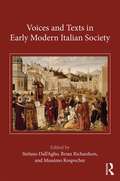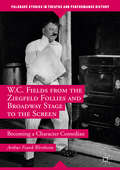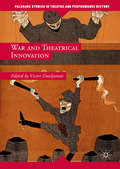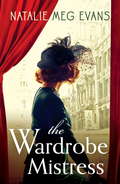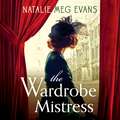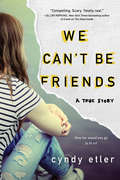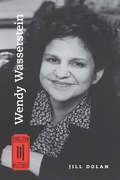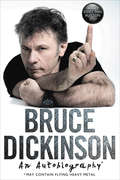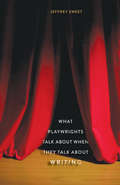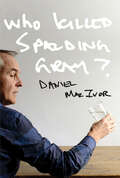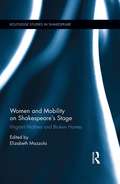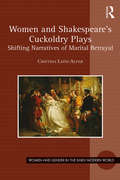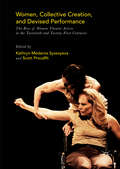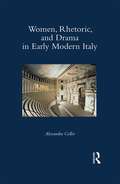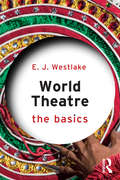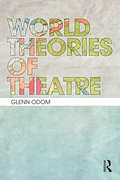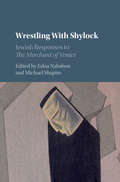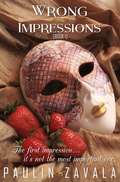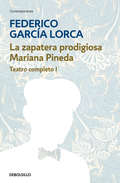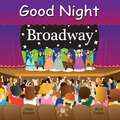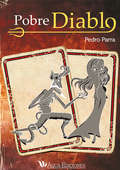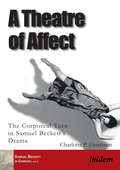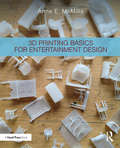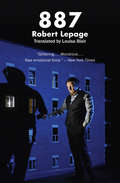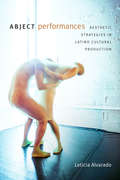- Table View
- List View
Voices and Texts in Early Modern Italian Society
by Stefano Dall'Aglio Brian Richardson Massimo RospocherThis book studies the uses of orality in Italian society, across all classes, from the fifteenth to the seventeenth century, with an emphasis on the interrelationships between oral communication and the written word. The Introduction provides an overview of the topic as a whole and links the chapters together. Part 1 concerns public life in the states of northern, central, and southern Italy. The chapters examine a range of performances that used the spoken word or song: concerted shouts that expressed the feelings of the lower classes and were then recorded in writing; the proclamation of state policy by town criers; songs that gave news of executions; the exercise of power relations in society as recorded in trial records; and diplomatic orations and interactions. Part 2 centres on private entertainments. It considers the practices of the performance of poetry sung in social gatherings and on stage with and without improvisation; the extent to which lyric poets anticipated the singing of their verse and collaborated with composers; performances of comedies given as dinner entertainments for the governing body of republican Florence; and a reading of a prose work in a house in Venice, subsequently made famous through a printed account. Part 3 concerns collective religious practices. Its chapters study sermons in their own right and in relation to written texts, the battle to control spaces for public performance by civic and religious authorities, and singing texts in sacred spaces.
W.C. Fields from the Ziegfeld Follies and Broadway Stage to the Screen
by Arthur Frank WertheimThis book reveals how Fields became a character comedian while performing in Broadway's most illustrious revue, the Ziegfeld Follies. As the first biography to use the recently opened Fields Papers at the Motion Picture Academy, the book explores how Fields years as a Follies entertainer portraying a beleaguered husband and a captivating conman became a landmark turning point in his career, leading to his fame as a masterful film comedian. The book also untangles a web of mysteries about Fields's turbulent private life, from the heartrending stories about the tragic relationship with his calculating wife who refused to divorce him, to his estranged son controlled by his mother, to the seven-year extra-marital affair with a chorus girl that led to the birth of an unwanted child. This electrifying saga illuminates a complex dual personality, whirling from tenderness to brusqueness, who endured so much anguish in order to bring the gift of laughter to millions. Although vilified by Ziegfeld and assailed by demons, Fields survived the cutthroat rigors of Broadway show biz to become a legendary American iconoclast and cultural icon.
War and Theatrical Innovation
by Victor EmeljanowThis book examines the relationship between wartime conflict and theatre practices. Bringing together a diverse collection of essays in one volume, it offers both a geographically and historically wide view of the subject, taking examples from Britain, Australia and America to the Middle East, Korea and China, and spanning the fifth century BCE to the present day. It explores the ways in which theatre practices have been manipulated for use in political and military propaganda, such as the employment of scenographers to work on camouflage and the application of acting methods in espionage training. It also maps the change in relationships between performers and audiences as a result of conflict, and the emergence of new forms of patronage during wartime theatre-going, boosting morale at periods when social structures and identity were being destabilized.
The Wardrobe Mistress: An evocative historical romance of hidden secrets that will capture your heart
by Natalie Meg EvansLondon 1945. A young war widow steps aboard a train in search of a new life. Clutching the key to a mysterious inheritance, Vanessa Kingcourt can no longer resist the pull of the old Farren Theatre, which is in need of a Wardrobe Mistress. With no experience and no budget for supplies, Vanessa must use her intuition to create beautiful costumes from whatever scraps survived the blitz. It's a seemingly impossible task, and one which may unravel family secrets sewn deep into the very fabric of the London theatre scene. . .
The Wardrobe Mistress: An evocative historical romance of hidden secrets that will capture your heart
by Natalie Meg EvansFrom the award-winning author of The Dress Thief comes a love story set in the glittering world of London theatre. Perfect for fans of Gill Paul and Lucinda Riley.London 1945. A young war widow steps aboard a train in search of a new life. Clutching the key to a mysterious inheritance, Vanessa Kingcourt can no longer resist the pull of the old Farren Theatre - an enchanted place seeped in memories of her actor father.Now owned by troubled former captain Alistair Redenhall, The Farren is in need of a Wardrobe Mistress and a new lease of life. With no experience and no budget for supplies, Vanessa must use her intuition to create beautiful costumes from whatever scraps of silk and thread survived the blitz. It's a seemingly impossible task, but a welcome distraction as she struggles to resist her blossoming feelings for Alistair.What Vanessa discovers could unravel family secrets sewn deep into the very fabric of the London theatre scene . . . but will she repeat the same terrible mistakes her father made? And can she dare to love a man who will never be hers?(P)2019 Quercus Editions Limited
We Can't Be Friends: A True Story
by Cyndy EtlerThe companion to The Dead Inside, "[An] unnerving and heartrending memoir" (Publishers Weekly) This is the story of my return to high school. This is the true story of how I didn't die. High school sucks for a lot of people. High school extra sucks when you believe, deep in your soul, that every kid in the school is out to get you. I wasn't popular before I got locked up in Straight Inc., the notorious "tough love" program for troubled teens. So it's not like I was walking around thinking everyone liked me. But when you're psychologically beaten for sixteen months, you start to absorb the lessons. The lessons in Straight were: You are evil. Your peers are evil. Everything is evil except Straight, Inc. Before long, you're a true believer. And when you're finally released, sent back into the world, you crave safety. Crave being back in the warehouse. And if you can't be there, you'd rather be dead.
Wendy Wasserstein
by Jill DolanPlaywright Wendy Wasserstein (1950–2006), author of The Heidi Chronicles, wrote topical, humorous plays addressing relationships among women and their families, taking the temperature of social moments from the 1960s onward to debate women’s rightful place in their professional and personal lives. The playwright’s popular plays continue to be produced on Broadway and in regional theaters around the country and the world. Wasserstein’s emergence as a popular dramatist in the 1970s paralleled the emergence of the second-wave feminist movement in the United States, a cultural context reflected in the themes of her plays. Yet while some of her comedies and witty dramas were wildly successful, packing theaters and winning awards, feminists of the era often felt that the plays did not go far enough. Wendy Wasserstein provides a critical introduction and a feminist reappraisal of the significant plays of one of the most famous contemporary American women playwrights. Following a biographical introduction, chapters address each of her important plays, situating Wasserstein’s work in the history of the US feminist movement and in a historical moment in which women artists continue to struggle for recognition.
What Does This Button Do?: An Autobiography
by Bruce DickinsonNew York Times Bestseller“Illuminating and very entertaining…a compelling read about someone who is much more than just the guy who sings for Iron Maiden.” —LoudwireA long-awaited memoir from the larger-than-life, multifaceted lead vocalist of Iron Maiden, one of the most successful, influential and enduring rock bands ever.Pioneers of Britain’s nascent Rock & Metal scene back in the late 1970s, Iron Maiden smashed its way to the top, thanks in no small part to the high-octane performances, operatic singing style, and stage presence of its second, but twice-longest-serving, lead singer, Bruce Dickinson. As Iron Maiden’s front man—first from 1981 to 1993, and then from 1999 to the present—Dickinson has been, and remains, a man of legend.But OTT front man is just one of the many hats Bruce wears. In addition to being one of the world’s most storied and well-respected singers and songwriters, he is an airline captain, aviation entrepreneur, motivational speaker, beer brewer, novelist, radio presenter, and film scriptwriter. He has also competed as a world-class level fencer. Often credited as a genuine polymath Bruce, in his own words (and handwritten script in the first instance!), sets forth many personal observations guaranteed to inspire curious souls and hard-core fans alike. Dickinson turns his unbridled creativity, passion, and anarchic humour to reveal some fascinating stories from his life, including his thirty years with Maiden, his solo career, his childhood within the eccentric British school system, his early bands, fatherhood and family, and his recent battle with cancer. Bold, honest, intelligent and very funny, his memoir is an up-close look inside the life, heart, and mind of one of the most unique and interesting men in the world; a true icon of rock.
What Playwrights Talk About When They Talk About Writing
by Jeffrey SweetThe art and craft of playwriting as explored in candid conversations with some of the most important contemporary dramatists Edward Albee, Lanford Wilson, Lynn Nottage, A. R. Gurney, and a host of other major creative voices of the theater discuss the art of playwriting, from inspiration to production, in a volume that marks the tenth anniversary of the Yale Drama Series and the David Charles Horn Foundation Prize for emerging playwrights. Jeffrey Sweet, himself an award-winning dramatist, hosts a virtual roundtable of perspectives on how to tell stories onstage featuring extensive interviews with a gallery of gifted contemporary dramatists. In their own words, Arthur Kopit, Marsha Norman, Christopher Durang, David Hare, and many others offer insights into all aspects of the creative writing process as well as their personal views on the business, politics, and fraternity of professional theater. This essential work will give playwrights and playgoers alike a deeper and more profound appreciation of the art form they love.
Who Killed Spalding Gray?
by Daniel MacIvorSit down, Daniel’s going to tell you a story. On the weekend of January 10, 2004, American monologist Spalding Gray killed himself by jumping off the Staten Island Ferry in New York City. That same weekend, Daniel MacIvor was in California, visiting a psychic surgeon who offered to save his life by removing a spiritual entity that had attached to him. But what if Spalding’s death had something to do with Daniel’s entity? Linking these two true parallel stories is fiction derived from Gray’s obsessions and MacIvor’s inventions about a man named Howard who had forgotten how to live.
Women and Mobility on Shakespeare’s Stage: Migrant Mothers and Broken Homes (Routledge Studies in Shakespeare)
by Elizabeth MazzolaLong before the economist Amartya Sen proposed that more than 100 million women were missing—lost to disease or neglect, kidnapping or forced marriage, denied the economic and political security of wages or membership in a larger social order—Shakespeare was interested in such women’s plight, how they were lost, and where they might have gone. Characters like Shakespeare’s Cordelia and Perdita, Rosalind and Celia constitute a collection of figures related to the mythical Persephone who famously returns to her mother and the earth each spring, only to withdraw from the world each winter when she is recalled to the underworld. That women’s place is far from home has received little attention from literary scholars, however, and the story of their fraught relation to domestic space or success outside its bounds is one that hasn’t been told. Women and Mobility investigates the ways Shakespeare’s plays link female characters’ agency with their mobility and thus represent women’s ties to the household as less important than their connections to the larger world outside. Female migration is crucial to ideas about what early modern communities must retain and expel in order to carve a shared history, identity and moral framework, and in portraying women as "sometime daughters" who frequently renounce fathers and homelands, or queens elsewhere whose links to faraway places are vital to the rebuilding of homes and kingdoms, Shakespeare also depicts global space as shared space and the moral world as an international one.
Women and Shakespeare's Cuckoldry Plays: Shifting Narratives of Marital Betrayal (Women and Gender in the Early Modern World)
by Cristina León AlfarHow does a woman become a whore? What are the discursive dynamics making a woman a whore? And, more importantly, what are the discursive mechanics of unmaking? In Women and Shakespeare’s Cuckoldry Plays: Shifting Narratives of Marital Betrayal, Cristina León Alfar pursues these questions to tease out familiar cultural stories about female sexuality that recur in the form of a slander narrative throughout William Shakespeare’s work. She argues that the plays stage a structure of accusation and defense that unravels the authority of husbands to make and unmake wives. While men’s accusations are built on a foundation of political, religious, legal, and domestic discourses about men’s superiority to, and rule over, women, whose weaker natures render them perpetually suspect, women’s bonds with other women animate defenses of virtue and obedience, fidelity and love, work loose the fabric of patrilineal power that undergirds masculine privileges in marriage, and signify a discursive shift that constitutes the site of agency within a system of oppression that ought to prohibit such agency. That women’s agency in the early modern period must be tied to the formations of power that officially demand their subjection need not undermine their acts. In what Alfar calls Shakespeare’s cuckoldry plays, women’s rhetoric of defense is both subject to the discourse of sexual honor and finds a ground on which to “shift it” as women take control of and replace sexual slander with their own narratives of marital betrayal.
Women, Collective Creation, and Devised Performance
by Kathryn Mederos Syssoyeva Scott ProudfitThis book explores therole and centrality of women in the development of collaborative theatrepractice, alongside the significance of collective creation and devising in thedevelopment of the modern theatre. Tracing a web of women theatremakers in Europeand North America, this book explores the connections between early twentiethcentury collective theatre practices such as workers theatre and the dramaticplay movement, and the subsequent spread of theatrical devising. Chaptersinvestigate the work of the Settlement Houses, total theatre in 1920s' France,the mid-century avant-garde and New Left collectives, the nomadic performancesof Europe's transnational theatre troupes, street-theatre protests, andcontemporary devising. In so doing, the book further elucidates a history of moderntheatre begun in A History of CollectiveCreation (2013) and CollectiveCreation in Contemporary Performance (2013), in which the seeminglymarginal and disparate practices of collective creation and devising arerevealed as central--and women theatremakers revealed as progenitors of thesepractices.
Women, Rhetoric, and Drama in Early Modern Italy
by Alexandra CollerSixteenth-century Italy witnessed the rebirth of comedy, tragedy, and tragicomedy in the pastoral mode. Traditionally, we think of comedy and tragedy as remakes of ancient models, and tragicomedy alone as the invention of the moderns. Women, Rhetoric, and Drama in Early Modern Italy suggests that all three genres were, in fact, remarkably new, if dramatists’ intriguingly sympathetic portrayals of and sustained investment in women as vibrant and dynamic characters of the early modern stage are taken into account. This study examines the role of rhetoric and gender in early modern Italian drama, in itself and in order to explore its complex interrelationship with the rise of women writers and the role women played in Italian culture and society, while at the same time demonstrating just how closely intertwined history, culture, and dramatic writing are. Author Alexandra Coller focuses on the scripted/erudite plays of the sixteenth and first half of the seventeenth centuries, which, she argues, are indispensable for a balanced view of the history of drama and its place within contemporary literary and women’s studies. As this book reveals, the ascendancy of comedy, tragedy, and tragicomedy in the vernacular seems to have been not only inextricably linked to but also dependent on the rise of women as prominent stage characters and, eventually, as authors in their own right.
World Theatre: The Basics (The Basics)
by E. J. WestlakeWorld Theatre: The Basics presents a well-rounded introduction to non-Western theatre, exploring the history and current practice of theatrical traditions in Asia, Africa, the Middle East, Oceania, the Caribbean, and the non-English-speaking cultures of the Americas. Featuring a selection of case studies and examples from each region, it helps the reader to understand the key issues surrounding world theatre scholarship and global, postcolonial, and transnational performance practices. An essential read for anyone seeking to learn more about world theatre, World Theatre: The Basics provides a clear, accessible roadmap for approaching non-Western theatre.
World Theories of Theatre
by Glenn A. OdomWorld Theories of Theatre expands the horizons of theatrical theory beyond the West, providing the tools essential for a truly global approach to theatre. Identifying major debates in theatrical theory from around the world, combining discussions of the key theoretical questions facing theatre studies with extended excerpts from primary materials, specific primary materials, case studies and coverage of Southern Africa, the Caribbean, North Africa and the Middle East, Oceania, Latin America, East Asia, and India. The volume is divided into three sections: Theoretical questions, which applies cross-cultural perspectives to key issues from aesthetics to postcolonialism, interculturalism, and globalization. Cultural and literary theory, which is organised by region, presenting a range of theatrical theories in their historical and cultural context. Practical exercises, which provides a brief series of suggestions for physical exploration of these theoretical concepts. World Theories of Theatre presents fresh, vital ways of thinking about the theatre, highlighting the extraordinary diversity of approaches available to scholars and students of theatre studies. This volume includes theoretical excerpts from: Zeami Motokiyo Bharata Muni Wole Soyinka Femi Osofisan Uptal Dutt Saadallah Wannous Enrique Buenaventura Derek Walcott Werewere Liking Maryrose Casey Augusto Boal Tadashi Suzuki Jiao Juyin Oriza Hirata Gao Xingjian Roma Potiki Poile Sengupta
Wrestling With Shylock
by Edna Nahshon Michael ShapiroShakespeare's The Merchant of Venice occupies a unique place in world culture. As the fictional, albeit iconic, character of Shylock has been interpreted as exotic outsider, social pariah, melodramatic villain and tragic victim, the play, which has been performed and read in dozens of languages, has served as a lens for examining ideas and images of the Jew at various historical moments. In the last two hundred years, many of the play's stage interpreters, spectators, readers and adapters have themselves been Jews, whose responses are often embedded in literary, theatrical and musical works. This volume examines the ever-expanding body of Jewish responses to Shakespeare's most Jewishly relevant play.
Wrong Impressions [Book I]
by Paulin Zavala Alejandra Mendoza ZacaríasHow much can it affect to want to meet someone? Idealization to a person is powerful and unpredictable. Will he be able to fulfill the expectations, which for years has been created on the girl? Allan Estrada is a man who had just lost his parents, he thought he would never be able to trust anyone, he had been in charge of a millionaire company and he had no idea how to handle it. His luck changed when he met Antonio, who supported him and helped him out of the shadows, and when he began to tell him about his youngest daughter, he was interested in meeting the girl. Only she did not make it easy.
La zapatera prodigiosa | Mariana Pineda (Teatro completo #1)
by Federico García LorcaLa zapatera prodigiosa | Mariana Pineda es el cuarto volumen de la Biblioteca Federico García Lorca y el primero que compila su «Teatro completo». La figura de Federico García Lorca abraca, tanto en España como en el exterior, mucho más que su literatura. En este libro se ofrecen al lector clásicos lorquianos como Mariana Pineda, La zapatera prodigiosa, Retablillo de don Cristóbal y la Tragicomedia de don Cristóbal, junto con la Charla sobre teatro ofrecida por el autor a modo de introducción a este arte. La edición y los prólogos, a cargo de Miguel García-Posada, permiten al lector acercarse a la complejidad de su obra y disfrutar, a lo largo de los siete volúmenes que componen esta Biblioteca Federico García Lorca, de uno de los autores españoles más relevantes del siglo XX. Pablo Neruda escribió:«Porque por ti pintan de azul los hospitalesycrecen las escuelas y los barrios marítimos,y se pueblan de plumas los ángeles heridos,y se cubren de escamas los pescados nupciales,y van volando al cielo los erizos:por ti las sastrerías con sus negras membranasse llenan de cucharas y de sangrey tragan cintas rotas, y se matan a besos,y se visten de blanco.» --------------------------------------------------------------------------BIBLIOTECA FEDERICO GARCÍA LORCA Poesía competa:1. Libro de poemas | Primeras canciones | Canciones2. Romancero gitano | Poema del cante jondo3. Poeta en Nueva York | Sonetos Teatro completo:4. La zapatera prodigiosa | Mariana Pineda5. El público | Así que pasen cinco años6. Bodas de sangre | Yerma7. La casa de Bernarda Alba | Doña Rosita la soltera--------------------------------------------------------------------------
Good Night Broadway (Good Night Our World)
by Adam Gamble Mark JasperGood Night Broadway highlights theaters, musicals, dancers, plays, actors and actresses, writers and directors, costumes, scripts, rehearsals, playbills, stagehands, and so much more. This adorable board book captivates young audiences as they tour one of the country's most electric and exciting destinations. In these colorful pages, readers receive a front-row ticket to the best of what Broadway has to offer. This book is part of the bestselling Good Night Our World series, which includes hundreds of titles exploring iconic locations and exciting themes.
Pobre diablo: Cuentos Y Relatos De Valor En Tiempos De Angustia
by Pedro ParraBrillante relato en donde el bien y el mal conviven en situaciones jocosas e inesperadas. Cada día iba siendo mayor la necesidad de calor y luz por parte de Lucifer y sus huestes. De sus demonios, el que ocupaba el escalafón más bajo era el Chamuco, quien tenía que permanecer muy cerca del fuego y en un descuido su hermoso cuerpo terminó calcinado. Por lo que a partir de ese día, hacía uso de cuerpos ajenos que tomaba prestados por momentos. Lo mismo era un cerdo, que un león o un ser humano, pero lo único que era en realidad, era un pobre diablo. Con el fin de ganar almas para su causa y llevar al Infierno la mayor cantidad de seres humanos, todos los demonios tuvieron la oportunidad de escoger una zona geográfica y población a conquistar. Es por eso que el Chamuco escogió a San Cirilo, pueblo alejado de la mano de Dios, como decían sus habitantes. La tradición del pueblo se integró con diversos personajes. Con la melodía de la flauta del Chamuco los habitantes se ven tentados a caer en el pecado y a pasar por encima de las leyes y la moral. Lo que el Chamuco no sabe es que su conquista no es tarea sencilla y tiene que ser muy astuto para manipular a los habitantes que algunas veces son más maliciosos que él.
A Theatre of Affect: The Corporeal Turn in Samuel Beckett's Drama (Samuel Beckett in Company #3)
by Charlotta P. EinarssonCombining phenomenological analysis with dance and performance analysis and affect theory, A Theatre of Affect: The Corporeal Turn in Samuel Beckett's Drama takes stock of the various ways in which the body in Samuel Beckett's drama participates in the affective ecology of performance. Affect is here located in the materiality of the body and discussed in relation to the symbolic significance of, for instance, the effort, direction, speed, or duration of a posture, movement, or gesture. Although the meaning of the body in Beckett's stage-images cannot be mapped onto conventional discursive meanings, the significance of the body's formal modulations is affective in the sense that the import of such changes is immediately recognized and felt as significant by spectators. Beckett's theater of affect therefore is predicated on the infinitesimal stirrings of subliminal meaning-making that continuously shape and create the world in experience.
3D Printing Basics for Entertainment Design
by Anne E. McMillsAffordable 3D printers are rapidly becoming everyday additions to the desktops and worktables of entertainment design practitioners – whether working in theatre, theme parks, television and film, museum design, window displays, animatronics, or… you name it! We are beginning to ask important questions about these emerging practices: · How can we use 3D fabrication to make the design and production process more efficient? · How can it be used to create useful and creative items? · Can it save us from digging endlessly through thrift store shelves or from yet another late-night build? · And when budgets are tight, will it save us money? This quick start guide will help you navigate the alphabet soup that is 3D printing and begin to answer these questions for yourself. It outlines the basics of the technology, and its many uses in entertainment design. With straightforward and easy-to-follow information, you will learn ways to acquire printable 3D models, basic methods of creating your own, and tips along the way to produce successful prints. Over 70 professionals contributed images, guidance, and never-before-seen case studies filled with insider secrets to this book, including tutorials by designer and pioneer, Owen M. Collins.
887
by Robert LepageFrom internationally acclaimed playwright and author Robert Lepage comes 887 — an autobiographical story originally toured as a solo show. Framed by Lepage’s attempt to memorize Michèle Lalonde’s poem “Speak White,” 887 is an exploration of memory, culture, and community in Quebec.As the 40th anniversary of La Nuit de la poésie in Montreal approaches, playwright Robert Lepage is invited to recite Michèle Lalonde’s seminal poem “Speak White” from memory on the special night. After agonizing hours spent attempting to memorize the piece, Lepage finds himself unable to recall a single line. In a last effort he decides to employ a mnemonic device dating back to ancient Greece called the Memory Palace — a technique of imagination and association. Lepage’s Memory Palace is 887 Murray Avenue, the apartment block where he grew up. Winding his way around the rooms of the building and the lives of the tenants therein, Lepage guides the reader through a world of recollections of 1960s Quebec, the decade that shaped the province’s cultural and political consciousness.A mesmerizing and multifaceted glimpse into the realm of memory, 887 is a tour of culture and community in 1960s Quebec through one masterful artist’s remarkable, boundary-defying perspective.
Abject Performances: Aesthetic Strategies in Latino Cultural Production (Dissident Acts)
by Leticia AlvaradoIn Abject Performances Leticia Alvarado draws out the irreverent, disruptive aesthetic strategies used by Latino artists and cultural producers who shun standards of respectability that are typically used to conjure concrete minority identities. In place of works imbued with pride, redemption, or celebration, artists such as Ana Mendieta, Nao Bustamante, and the Chicano art collective known as Asco employ negative affects—shame, disgust, and unbelonging—to capture experiences that lie at the edge of the mainstream, inspirational Latino-centered social justice struggles. Drawing from a diverse expressive archive that ranges from performance art to performative testimonies of personal faith-based subjection, Alvarado illuminates modes of community formation and social critique defined by a refusal of identitarian coherence that nonetheless coalesce into Latino affiliation and possibility.
